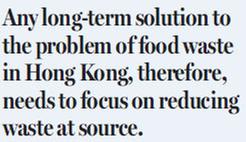Reducing food waste is everyone's concern

Every day some 3,350 tons of food waste is dumped in the landfills of Hong Kong, according to figures provided by the Environmental Protection Department. The figures, which cover the year 2015, mean food waste makes up an incredible 33 percent of our municipal solid waste. With all three landfills in the special administrative region expected to run out of space within the next three years, this wastefulness is clearly unsustainable.
So what can we do to reduce the amount of food waste sent to landfill? Well, we could start by looking at what our compatriots have done in Taiwan, where the government introduced an island-wide mandatory waste-separation program in 2006. The program, which requires the public to sort their garbage into recyclables, food waste and residual waste, includes a fine of NT$1,200 ($40, or just over HK$300) for anyone who fails to separate their waste correctly following an initial warning. Around three-fourths of the food waste collected is sold to pig farms, with nearly all the rest composted.
Now, obviously Hong Kong is not Taiwan, and what worked there may not work well here. For one thing Hong Kong has fewer than 100,000 pigs, compared with a swine population of 5.5 million in Taiwan. It also lacks a large-scale composting plant, although a 200-ton-a-day organic-waste treatment facility (OWTF) is due to be commissioned on Lantau Island later this year. Any long-term solution to the problem of food waste in Hong Kong, therefore, needs to focus on reducing waste at source.
Fortunately the government clearly realizes this. In 2014 the Environment Bureau (ENB) issued "A Food Waste and Yard Waste Plan for Hong Kong 2014-2022", which set a target of reducing food-waste disposal to landfill by 40 percent by 2022, with reduction at source identified as the key strategy. However, even if the ENB succeeds in meeting its target, it will still have some 1,500 tons a day of food waste on its hands, even after the commissioning of a second, 300-ton-a-day OWTF in Sha Ling in 2021.

The good news here is that the ENB's target is actually quite conservative. After all, the average Hong Kong resident currently generates as much as 0.37 kilograms of domestic food waste per day - some 85 percent more than his or her counterpart in Taipei. So by simply bringing the level of domestic food waste down to that of the average Taipei household, we could reduce the total amount of food waste generated by as much as 1,500 tons a day.
But how? Well, we can start by only buying what we need when we go food shopping. We can also make use of food trimmings and leftovers, and we can use a first-in-first-out (FIFO) system for food storage.
Another thing we can do is change our attitude toward expiration dates. Sell-by dates should be disregarded altogether, as they are essentially a stocking tool for retailers, while use-by and best-before dates should be regarded with circumspection, as they are indications of freshness not safety.
We can also reduce food waste when we eat out, by not ordering too much and "doggy-bagging" any uneaten food. We can also patronize restaurants with green credentials - for example those participating in the ENB's Food Wise Eateries Scheme.
Reducing food waste in the commercial sector is a moral imperative, as the unconscionable amount of food waste generated at retail outlets here comes at a time when more than a million people in the city live below the poverty line. Fortunately environmental groups such as Friends of the Earth (HK) and faith-based charities like the Sathya Sai International Organisation Hong Kong are stepping in to help shops and restaurants donate surplus food to people in need. However the amount of food redistributed is still only a drop in the bucket.
Not all food waste, however, can be redistributed, so we also need to think about recycling. Given the paucity of Hong Kong's pigs and the limited capacity of its OWTFs, this means exploring the possibility of setting up our own composting projects, with help from the Environment and Conservation Fund. At the moment only about 5 percent of residential properties have food recycling schemes. If we can find a way of reversing this figure, so that only 5 percent do not, we will be well on our way to achieving the holy grail of food-waste reduction: a total ban on food waste in landfills.
This may sound like a utopian goal but it has already been achieved in countries like Germany, Sweden and Denmark. If they can do it, then surely we can too.
The author is a journalist and former civil servant.
(HK Edition 08/22/2017 page8)































